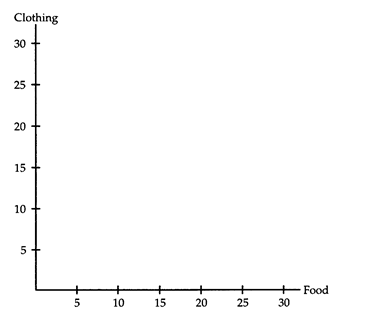The short run in macroeconomics is a period in which nominal wages:
A. change as the price level stays constant.
B. do not respond as the price level changes.
C. change as the price level changes.
D. do not respond as the price level stays constant.
Answer: B
You might also like to view...
Consider the following:
(i) Suppose Laurent has $60 per week to spend on food and clothing. The price of food is $4 per unit, and the price of clothing is $6 per unit. Sketch Laurent's budget line on the axes provided.
(ii) Laurent applies to the local government for food stamps and is given $40 worth of food stamps per week. On the axes, show how the receipt of food stamps affects Laurent's budget line.
(iii) Suppose that instead of food stamps, Laurent receives $40 in cash per week from a relative. On the axes, show how this gift affects Laurent's budget line.
(iv) Add appropriate indifference curves to the diagram to show that a gift of $40 in cash could make Laurent better off than the receipt of $40 in food stamps.

Suppose a farmer raising beef is making a normal profit. Then, because of a scare about mad cow disease, the demand for beef decreases drastically. What happens to the profits of the beef farmer in the short run and in the long run?
What will be an ideal response?
A ________ in market interest rates relative to the discount rate will cause discount borrowing to_______
A) fall; increase B) rise; decrease C) rise; increase D) fall; remain unchanged
Which of the following would not be considered an automatic stabilizer?
A) rising corporate income tax revenues due to an expanding economy B) increasing food stamp payments due to more people becoming unemployed during a recession C) legislation increasing funding for job retraining passed during a recession D) decreasing unemployment insurance payments due to increased employment during an expansion